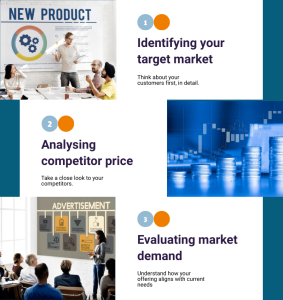


Blogs I gepubliceerd 10 June 2024 I Dirk Hoogenboom
Een Vijf Stappen Gids om de Optimale Productprijs te Bepalen
Het bepalen van de optimale productprijs is een evenwichtsoefening: u moet waarde bieden aan klanten terwijl u de winstgevendheid van uw bedrijf waarborgt. Hoewel dit misschien willekeurig lijkt, zijn er stappen die u kunt nemen om ervoor te zorgen dat uw prijs in lijn is met de huidige markttrends en de juiste waarde aan uw product toekent. Dit vereist een zorgvuldige evaluatie en strategische planning. Door de vijf stappen in deze gids te volgen, kunt u er zeker van zijn dat u op de goede weg bent naar het optimaliseren van uw prijzen voor langdurig succes.
Stap 1: Marktonderzoek
Het begrijpen van uw markt is essentieel voor elke bedrijfsstrategie, vooral als u de concurrentie voor wilt blijven. Dit begint met uitgebreid marktonderzoek. Het kennen van de belangrijkste spelers in uw veld geeft u de informatie die u nodig heeft om uw bedrijf strategisch te positioneren. Richt u op de volgende punten:
Identificeer uw Doelmarkt
Denk eerst na over uw klanten, in detail. Voer enquêtes en focusgroepen uit om hun kenmerken te achterhalen. Wie zijn ze? Wat zijn hun behoeften, voorkeuren en gewoonten? Wat is de waargenomen waarde van uw product? Hoe gevoelig zijn ze voor prijswijzigingen? Hoe meer u over hen weet, hoe beter u de juiste prijs kunt bepalen.
Analyseer de Prijzen van Concurrenten
Kijk vervolgens goed naar uw concurrenten. Wat vragen zij voor vergelijkbare producten? Door succesvolle concurrenten te analyseren, kunt u bepalen welke prijsstrategieën werken en hoe u uw aanbod kunt onderscheiden.
Evalueer de Marktvraag
Is er een echte behoefte aan wat u aanbiedt, of betreedt u een al verzadigde markt? Begrijp de trends in de sector en de gewoonten van klanten om potentiële hiaten in uw vakgebied te ontdekken.


Stap 2: Begrijp uw Kosten
Na uitgebreid marktonderzoek moet u inzicht krijgen in de kosten van uw bedrijf, wat verder gaat dan alleen het optellen van uitgaven. Weten wat uw kosten zijn, stelt u in staat om weloverwogen beslissingen te nemen, zowel bij de marktintroductie als op de lange termijn.
Vaste versus Variabele Kosten
Elk bedrijf maakt kosten, maar niet alle kosten zijn gelijk. Vaste kosten (zoals huur, salarissen en verzekeringen) blijven constant, terwijl variabele kosten (zoals materialen en transport) afhankelijk zijn van de productie. Beide kosten moeten worden meegenomen in uw prijsstrategie.
Bereken Totale Kosten
Nadat u de vaste en variabele kosten heeft geïdentificeerd, kunt u de totale kosten berekenen voor een bepaalde periode. Dit helpt u om de winstgevendheid te beoordelen en kostenbesparende mogelijkheden te identificeren.


Stap 3: Overweeg uw Bedrijfsdoelen
Het is belangrijk om uw prijsstrategie af te stemmen op uw bedrijfsdoelen. Denk na over uw toekomstvisie: richt u zich op snelle winst of op duurzame groei?
Korte- versus Langetermijndoelen
Een korte-termijnstrategie kan lage prijzen hanteren om snel marktaandeel te veroveren, terwijl lange termijn doelen zich richten op winstgevendheid en stabiele groei. Uw prijsstelling moet uw kosten dekken en tegelijkertijd winst genereren.
Winstmarge Doelen
Het is cruciaal om een duidelijke winstmarge vast te stellen. Winstmarges helpen u om uw prijsstrategie te kwantificeren en te controleren of u uw doelstellingen behaalt.
Marktpenetratie versus Afroming
Wilt u snel marktaandeel winnen of focust u zich op maximale winst in een vroeg stadium? Marktpenetratie richt zich op een lage instapprijs, terwijl afroming een hogere beginprijs hanteert die later wordt verlaagd.


Stap 4: Kies een Prijsstrategie
Het kiezen van de juiste prijsstrategie is essentieel. Enkele populaire strategieën zijn:
Cost-Plus Pricing
Hierbij wordt de verkoopprijs bepaald door een winstpercentage toe te voegen aan de kosten van het product. Dit is een eenvoudige methode, maar houdt geen rekening met de klantperceptie of de prijzen van concurrenten.
Waarde-gebaseerde Prijsstelling
Deze methode stelt prijzen vast op basis van de waargenomen waarde voor de klant. Dit vereist een goed begrip van uw doelmarkt en wordt vaak toegepast bij luxeproducten of technologie.
Dynamische Prijsstelling
Deze strategie past prijzen aan op basis van realtime marktomstandigheden, zoals vraag, concurrentie en klantgedrag. Dit is vooral nuttig in sectoren zoals vervoer, horeca en evenementen.


Stap 5: Test en Pas uw Prijs Aan
Nu u een prijs heeft bepaald, is het belangrijk om te beseffen dat dit geen eenmalige beslissing is. Marktschommelingen en veranderende omstandigheden vereisen dat u uw prijsstrategie regelmatig heroverweegt.
A/B-testen
Bij A/B-testen splitst u uw klantenbestand in twee groepen om verschillende prijzen te testen. Dit helpt u te bepalen welke prijs het beste werkt voor uw klanten.
Verzamel Klantfeedback
Door naar klanten te luisteren, kunt u waardevolle inzichten krijgen over uw prijsstrategie. Enquêtes, focusgroepen en beoordelingen kunnen helpen om direct feedback te krijgen.
Door deze vijf stappen te volgen, kunt u de optimale prijs voor uw product bepalen en uw bedrijf winstgevend en competitief houden.
Volg Markttrends
Blijf op de hoogte van nieuwe trends, acties van concurrenten en economische verschuivingen om ervoor te zorgen dat uw prijs relevant blijft.



Lees verder


07 april 2025 I Dirk Hoogenboom
Marktonderzoek in de Installatiesector – Geen Giswerk Meer Nodig


04 april 2025 I Dirk Hoogenboom
Besluitvorming in de Bouw is Niet Simpel – Waarom Marktonderzoek een Concurrentievoordeel Oplevert


24 maart 2025 I Dirk Hoogenboom
Waarom Trekken Klanten Zich Terug uit Duurzame Bouwinvesteringen?


17 maart 2025 I Dirk Hoogenboom
De Staat van Woningverbetering: Belangrijke Trends en Marktinzichten

Verse inzichten staan klaar
Onze relevante rapporten
Bekijk onze meest recente marktrapportages voor de bouw-, installatie- en doe-het-zelfmarkt, gebaseerd op solide kwantitatief onderzoek.
Bouw
Doe-het-zelf
Installatie
Speciale rapporten
Bouw
Trends in materiaalgebruik Q1 2024
2024 102 paginas
Ontdek de evoluerende trends in materiaalgebruik onder Europese architecten in Q1 2024. Duik in de factoren die materiaalvoorkeuren bepalen en de impact op de esthetiek en duurzaamheid van de bouw.
2,000 euro
Bouw
Media-oriëntatie H2 2021
2024 161 pagina's
Verken de media-betrokkenheidspatronen van aannemers om uw marketingstrategieën te optimaliseren. Duik in een pool van inzichten die onthult hoe aannemers omgaan met verschillende mediakanalen.
6,300 Euro
Bouw
European Green Deal Q4 2021
2024 88 pages
Explore the impact and reception of the European Green Deal among architects. Understand how the initiative is influencing architectural practices and sustainability measures.
1,850 Euro
Bouw
Koop kanalen H2 2023
2024 123 pagina's
Ontdek het koop- en bestelgedrag onder aannemers in H2 2023. Ontdek de belangrijkste gebruikte kanalen, share-of-wallet en nog veel meer.
6,000 Euro
Bouw
Prefab in aanbouw Q3 2023
2023 90 pagina's
Verdiep je in de invloedrijke rol van aannemers binnen de besluitvormingseenheden van de bouw. Onderzoek de dynamiek en de mate van impact die aannemers hebben bij cruciale bouwbeslissingen.
1,850 Euro
Bouw
Gedragssegmentatie en mediagebruik 2023
2023 75 pagina's
Dit rapport geeft een uitgebreid overzicht van koopgedrag, producten en mediagebruik, specifiek gericht op Europese klusjesmannen. Het gaat in op hoe klussers media gebruiken, en voor welke doeleinden, en onderzoekt hun gewoonten en voorkeuren op het gebied van koopgedrag.
8,600 Euro
Doe-het-zelf
Branding Q3 2024
2024 74 pages
Discover the power of branding in the home improvement sector. Explore how strong branding influences consumer preferences and purchase decisions.
3,500 Euro
Doe-het-zelf
Sustainability Q1 2024
2024 81 pages
Delve into sustainability trends in the home improvement sector in Q1 2024. Discover consumer preferences and the shift towards eco-friendly home improvement solutions.
3,500 Euro
Doe-het-zelf
DIY versus DIFM Q4 2021
2024 113 pagina's
Dit rapport is een must-have als u in de woningverbeteringsindustrie werkt. Het biedt een schat aan informatie over het gedrag van doe-het-zelf- en DIFM-consumenten, hun motivaties en de factoren die hun aankoopbeslissingen beïnvloeden.
3,150 Euro
Doe-het-zelf
Doe-het-zelf of doe-het-voor-mij Q4 2023
2024 70 pagina's
Ontdek de heersende trends tussen doe-het-zelf en DIFM in Q4 2023. Begrijp de voorkeuren van de consument en de factoren die van invloed zijn op hun keuze tussen doe-het-zelf en DIFM.
3,500 Euro
Doe-het-zelf
Branding Q3 2023
2023 93 pagina's
Dit rapport biedt een uitgebreid overzicht van de doe-het-zelfbranche, met een focus op branding en de meest populaire merken binnen verschillende categorieën. In dit rapport krijgt u inzicht in hoe klanten merken voor woningverbetering ervaren en wat hen motiveert om bepaalde producten te kopen.
3,500 Euro
Doe-het-zelf
Inkoop kanalen Q2 2023
2023 114 pagina's
De European Home Improvement Monitor biedt waardevolle inzichten in aankoopkanalen in de Europese doe-het-zelfsector en onderzoekt de veranderende voorkeuren en gedragingen van consumenten in de traditionele detailhandel en opkomende online platforms.
3,500 Euro
Installatie
Duurzaamheid Q1 2024
2024 99 pagina's
Het European Electrical Installation Monitor rapport geeft een gedetailleerde analyse van de duurzame oplossingen in de installatiebranche. Dit rapport richt zich specifiek op duurzaamheidsaspecten in de industrie.
3,250 Euro
Installatie
Challenges toward sustainable future Q4 2021
2024 111 pages
2,650 Euro
Installatie
Inkoop kanalen Q4 2021
2024 106 pagina's
Verdiep je in de opleidingsbehoeften binnen de elektrotechnische installatiesector. Begrijp de gebieden die de ontwikkeling van vaardigheden vereisen om aan de veranderende eisen van de industrie te voldoen.
3,150 Euro
Installatie
Opleidingsbehoeften Q4 2023
2024 110 pagina's
Dit rapport onderzoekt de opleidingsbehoeften van installateurs, zowel digitaal als persoonlijk. Het volledige rapport behandelt alle belangrijke opleidingsbehoeften en -aspecten en biedt een uitgebreid overzicht van de bedrijfsontwikkeling in de installatiesector in belangrijke Europese landen.
2,800 Euro
Installatie
Inkoop kanalen Q4 2023
2024 97 pagina's
Dit rapport biedt een uitgebreid overzicht van het koop- en bestelgedrag van e-installateurs in Europa. In het rapport vind je belangrijke informatie over de inkoopkanalen die installateurs gebruiken, de share-of-wallet per kanaal, de manier van bestellen en nog veel meer.
3,250 Euro
Installatie
Inkoop kanalen Q3 2023
2023 106 pagina's
Dit rapport geeft een uitgebreid beeld van de houding van installateurs ten opzichte van aankoopkanalen, met name onder HVAC-installateurs. In het rapport vind je inzichten in koopgedrag, welke kanalen het meest worden gebruikt, welke groeien en of online kanalen steeds meer geaccepteerd worden.
2,800 Euro









